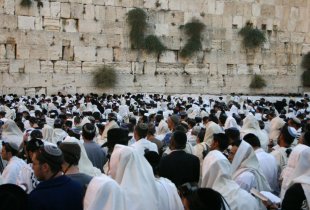
Concluding the “Ten Days of Repentance,” also known as the “Days of Awe,” Yom Kippur is a day where few Jews venture further than home and a house of worship. Expect that most Jews you know will forgo their usual weekend routines. Instead of holding tickets to movies or concerts Friday night, they will have tickets for seats at a Kol Nidrei Service.

Before Yom Kippur Jews seek out and reconcile with friends, colleagues, family members and even enemies. Yom Kippur is the time to forgive and move on. “If we cannot forgive others,” said the Hassidic Master Israel Ba’al Shem Tov, “how can we expect God to forgive us?”

Jewish tradition outlines three paths to help along this process of fixing our lives leading up to and during Yom Kippur:

Tzedakah (Charity) - The ethical imperative to contribute our resources to support the needy, our communal organizations, and to make the world a better place.

Teshuvah (Repentance)- Acknowledging our shortcomings, showing regret for what we did, and resolving to not make the same mistakes again, reconciles our relationship with God.
Tefillah (Prayer)- Opening our hearts, putting thoughts into words, we pray in the plural, asking for the good of all, not for our own personal needs.
Some perform the ritual of kapparot, where we symbolically transfer our sins to an object which is then donated to charity. Even if we gave tzedakah before Rosh Hashanah, now is the time to double-down, and give more. At home our dining tables are prepared with white linens and before sun sets we will light candles as if for a festive meal.
For the next 25 hours, adults refrain from food or drink. We wear simple shoes without leather, forgo bathing and intimacy, and don’t even watch the playoffs. We congregate in temples and synagogues around the world in the evening to hear Kol Nidrei, a moving prayer which begins a day-long dialogue with God.
Most Jews dress to show the solemnness of the day, wearing white prayer shawls and yarmulkas. The very pious wear a special garment called a kittel which reminds us of burial shrouds. The Ark is covered in white tapestry and all the Torahs are taken out and held around the dais.
We pray for many hours, confessing our mistakes to God and striking our chests over the sins we and our community have committed. We chant the moving verses of the Unetaneh Tokef:
“On Rosh Hashanah will be inscribed and on Yom Kippur will be sealed, how many will pass from the earth and how many will be created; who will live and who will die...who by water and who by fire...Who will rest and who will wander, who will live in harmony and who will be harried, who will enjoy tranquility and who will suffer, who will be impoverished and who will be enriched, who will be degraded and who will be exalted.”
A special prayer, Yizkor, is recited to remember our departed loved ones. We read aloud the Book of Jonah about a man who thought he could outrun God, and learn a lesson about compassion. Yom Kippur concludes with a final prayer called Neila, before the figurative Gates of Heaven close to our prayers. We shout out seven times our holiest prayer “Shema Yisrael” and sound one long blast of the Shofar.
There is also a majestic and universal message of Yom Kippur which is undoubtedly the basis of many self-improvement books: no matter what we have done wrong this past year - there is an opportunity to fix it. Each of the main elements of the external observance of the Holy Day refer to a deep spiritual message.
Fasting on Yom Kippur helps us put our spiritual life before our physical needs and wants. We prove to ourselves and to God that we are the masters of our own destiny. We realize that we are more than flesh and bones, we are also spiritual beings that need to be nurtured and nourished. Fasting also helps us empathize with those who do without enough food and water every day. Our day of self-denial and asceticism is by choice, whereas millions are forced to endure hunger every day.
Communal worship reminds us that our lives do not transpire in a vacuum. Rather, our actions and deeds affect each another and the whole world. Wearing white invokes the memory of the Holy Temple in Jerusalem, where the the High Priest in ancient days sought forgiveness for the Jewish nation 2000 years ago.
Just observing Yom Kippur cleanses our souls from the spiritual dirt that has accumulated and prevents us from enjoying each moment of life. Yom Kippur literally renews our lives and gives us a clean slate for the coming year. The mistakes, errors in judgement, and selfishness that got us in trouble last year, can be forgiven by humanity and God on Yom Kippur.
If only our credit scores could also be forgiven.
May the lessons of Yom Kippur inspire us to show compassion, forgiveness, and love to ourselves and each other, and renew our souls.
Source : http://www.washingtonpost.com/blogs/guest-voices/post/yom-kippur-etiquette-guide-forgive-and-be-forgiven/2011/10/07/gIQArOuTSL_blog.html
